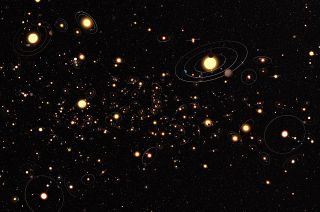Discovery! Kepler Space Telescope Discovers 95 More Alien Planets

The exoplanet discoveries by NASA's Kepler space telescope keep rolling in.
Astronomers poring through data gathered during Kepler's current extended mission, known as K2, have spotted 95 more alien planets, a new study reports.
That brings the K2 tally to 292, and the total haul over Kepler's entire operational life to nearly 2,440 — about two-thirds of all the alien worlds ever discovered. And more than 2,000 additional Kepler candidates await confirmation by follow-up observations or analysis. [7 Greatest Exoplanet Discoveries by NASA's Kepler (So Far)]
Kepler launched in March 2009, on a mission to help scientists determine just how common rocky, potentially habitable worlds such as Earth are throughout the Milky Way. For four years, the spacecraft stared continuously at about 150,000 stars, looking for tiny dips in their brightness caused by the passage of planets across their faces.
This work was highly productive, as noted above. But in May 2013, the second of Kepler's four orientation-maintaining "reaction wheels" failed, and the spacecraft lost its superprecise pointing ability, bringing the original mission to a close.
But mission managers figured out a way to stabilize Kepler using sunlight pressure, and the spacecraft soon embarked on its K2 mission, which involves exoplanet hunting on a more limited basis, as well as observing comets and asteroids in our own solar system, supernovas and a range of other objects and phenomena.
For the new study, researchers analyzed K2 data going all the way back to 2014, zeroing in on 275 "candidate" signals.
Get the Space.com Newsletter
Breaking space news, the latest updates on rocket launches, skywatching events and more!
"We found that some of the signals were caused by multiple star systems or noise from the spacecraft," study lead author Andrew Mayo, a Ph.D. student at the Technical University of Denmark's National Space Institute, said in a statement. "But we also detected planets that range from sub-Earth-sized to the size of Jupiter and larger."
Indeed, 149 of the signals turned out to be caused by bona fide exoplanets, 95 of which are new discoveries. And one of the new ones is a record setter.
"We validated a planet on a 10-day orbit around a star called HD 212657, which is now the brightest star found by either the Kepler or K2 missions to host a validated planet," Mayo said. "Planets around bright stars are important because astronomers can learn a lot about them from ground-based observatories."
The new study was published today (Feb. 15) in The Astronomical Journal.
Follow Mike Wall on Twitter @michaeldwall and Google+. Follow us @Spacedotcom, Facebook or Google+. Originally published on Space.com.
Join our Space Forums to keep talking space on the latest missions, night sky and more! And if you have a news tip, correction or comment, let us know at: community@space.com.

Michael Wall is a Senior Space Writer with Space.com and joined the team in 2010. He primarily covers exoplanets, spaceflight and military space, but has been known to dabble in the space art beat. His book about the search for alien life, "Out There," was published on Nov. 13, 2018. Before becoming a science writer, Michael worked as a herpetologist and wildlife biologist. He has a Ph.D. in evolutionary biology from the University of Sydney, Australia, a bachelor's degree from the University of Arizona, and a graduate certificate in science writing from the University of California, Santa Cruz. To find out what his latest project is, you can follow Michael on Twitter.
